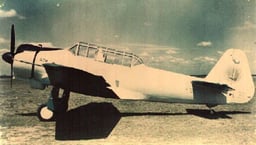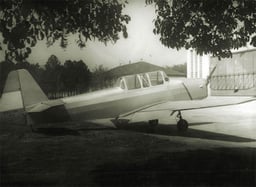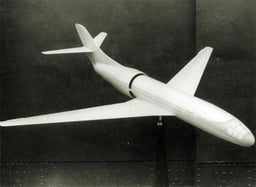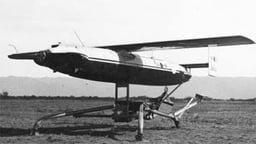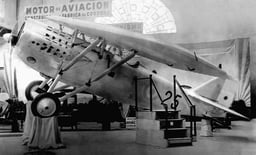Fábrica Argentina de Aviones

Fábrica Argentina de Aviones

 | |
Type | Sociedad Anónima |
|---|---|
| Industry | Aerospace, Defense |
| Founded | 1927 |
| Headquarters | Córdoba, Argentina |
Key people | Matías Julián Savoca (chairman)[1] |
| Products | Aircraft, aircraft components, aircraft maintenance and services |
Number of employees | 1,600 (as of June 2014) |
| Website | www.fadeasa.com.ar [17] |
The Fábrica Argentina de Aviones SA (FAdeA), officially Fábrica Argentina de Aviones "Brigadier San Martín" S.A., is Argentina's main aircraft manufacturer. Founded on 10 October 1927 and located in Córdoba, for most of its existence it was known as Fábrica Militar de Aviones (FMA), until its privatization in the 1990s to Lockheed Martin. In 2009 the concession ended and is wholly owned by the Argentine government.
 | |
Type | Sociedad Anónima |
|---|---|
| Industry | Aerospace, Defense |
| Founded | 1927 |
| Headquarters | Córdoba, Argentina |
Key people | Matías Julián Savoca (chairman)[1] |
| Products | Aircraft, aircraft components, aircraft maintenance and services |
Number of employees | 1,600 (as of June 2014) |
| Website | www.fadeasa.com.ar [17] |
History

1930s view of the FMA workshop

Late 1940s view of the FMA/IAe "Hangar 90" production line: I.Ae.22 DL (back) and I.Ae.24 Calquín (front)

1960s view of the production line: Morane Saulnier 760
Formed on 10 October 1927 and on 18 July 1928 ends the construction and testing begins on the track the first domestically produced aircraft: the license built Avro 504 Gosport training aircraft equipped with a 100 hp (75 kW) Gnome engine. It had a speed of 140 km/h with a flying endurance of 2 hours. A series of indigenous and foreign designs followed, mostly for military use.
The factory is known for producing the first jet fighter aircraft in Latin America: the Pulqui I (1947) and the Pulqui II (1950) under the direction of engineers Emile Dewoitine (French) and Kurt Tank (German) respectively.
In the 1960s produced the Guarani light transport and the Pucara COIN aircraft, followed by the Pampa jet trainer in the 1980s; the last two still in service with the Argentine Air Force as of early 2016.
Privatization (1995)
In 1995, FMA was privatized by the government of Carlos Menem and from that year until March 2009 it operated as a concession to LAASA (Lockheed Aircraft Argentina SA, a subsidiary of Lockheed Martin Corporation). Under the terms of the privatization agreement LAASA would operate it for 25 years, which could be renewed for two 10 year periods.
During this period the activity was mostly focused in maintenance and upgrades of existing aircraft in service with the Argentine Air Force.
Nationalization (2010)
It was renamed after Argentine Air Force Brigadier es:Juan Ignacio San Martín a military engineer who laid the foundations of the aeronautics industry at Córdoba when he directed the Instituto Aerotécnico, the forerunner of the FMA, in the 1940s.
The United States Department of State announced that effective 18 December 2009, Lockheed Martin Aircraft Argentina would be renamed to Fábrica Argentina de Aviones "Brigadier San Martin" S.A. and divested to the Government of Argentina.[4]
Aircraft design and production

AeMB.2 Bombi bombers in flight

Pulqui I prototype in flight (c.1951)

I.Ae. 33 Pulqui II

DINFIA IA 35 Huanquero, utility aircraft designed in the early 1950s

Prototype IA 38 Naranjero under construction, early 1960s

IA 46 ‘’Super Ranquel’’ at San Justo airfield (Buenos Aires), April 1975

I.A. 50 Guarani II

I.A. 58 Pucará

I.A. 63 Pampa II
The FMA has produced innovative aircraft prototypes, but the state of the Argentine economy has usually prevented most of them from entering large-scale production. Nevertheless the FMA has managed to put several aircraft types of more conventional designs into full productions. It also engaged in production of licensed aircraft from other countries.
The prefixes used for the aircraft locally developed (and produced) are:
Ae, for "Dirección General de Aerotécnica", on the first period (1927–1936);
F.M.A., for "Fábrica Militar de Aviones", on the second period (1938–1943);
I.Ae., for "Instituto Aerotécnico", on the third period (1943–1952);
IA, meaning not specified, on the fourth (current) period (1952 to present).
List of aircraft manufactured, projected, or upgraded
| Year | Model | Built | Obs |
|---|---|---|---|
| Started as Instituto Aerotécnico | |||
| 1928 | Avro 504K "Gosport" | 31 | Biplane basic trainer, license-built. First aircraft produced by FMA. |
| 1930 | Dewoitine D.21 | 35 | Monoplane fighter, license-built. |
| 1931 | FMA AeC.1 | 1 | Civil tourism aircraft prototype (initial version); basic trainer (later version). First local design. |
| 1932 | FMA AeC.2 | 2 | Civil tourism aircraft |
| 1932 | FMA AeME.1 | 7 | basic military trainer |
| 1933 | FMA AeT.1 | 3 | Transport/commercial aircraft |
| 1934 | FMA AeMO.1 | 41 | Observation monoplane |
| 1934 | FMA AeMOe.1 | 6 | Derivative of the AeMO.1, observation and training |
| 1934 | FMA AeMOe.2 | 61 | Variant of the AeMOe.1, observation and training |
| 1934 | FMA AeC.3 | 16 | Civil aircraft. |
| 1935 | FMA AeMB.1 | 1 | First bomber aircraft built by FMA |
| 1935 | FMA AeMB.2 | 14 | First bomber aircraft built by FMA |
| 1935 | FMA AeMS.1 | 1 | Ambulance aircraft |
| 1936 | FMA AeC.3G | 1 | Tourism aircraft. |
| 1936 | FMA AeC.4 | 1 | Improved prototype version of the C.3G |
| Name changed to Fabrica Militar de Aviones | |||
| 1940 | Curtiss Hawk 75O | 20 | License built version of the US monoplane fighter Curtiss Hawk 75[5] |
| 1940 | Focke-Wulf Fw 44J Stieglitz | 190 | License built version of the German biplane trainer |
| 1940 | FMA I.Ae.20 El Boyero | 130 | Tourism aircraft, series built by "Industrias Petrolini" |
| 1943 | FMA I.Ae.21 | 1 | Advanced trainer aircraft prototype, based on the North American NA-16-1P fuselage. |
| 1943 | FMA I.Ae.22 DL | 206 | Advanced trainer aircraft |
| 1945 | FMA I.Ae.23 | 1 | Basic trainer prototype, based on the Focke-Wulf Fw44J |
| 1945 | FMA I.Ae.25 Mañque | 1 | Assault/Transport glider. |
| 1946 | FMA I.Ae.24 Calquín | 100 | Attack/Light bomber |
| 1947 | FMA I.Ae.27 Pulqui | 1 | Jet fighter prototype, first of its kind built in Latin America. |
| 1947 | FMA I.Ae.31 Colibrí | 3 | Two-seat Trainer aircraft |
| 1948 | FMA I.Ae.30 Ñancú | 1 | Fighter/Attack prototype |
| 1949 | FMA I.Ae.32 Chingolo | 1 | Tourism/Trainer aircraft |
| 1949 | FMA I.Ae.34 Clen Antú | 3+1+3 | Glider, flying wing. Designed by Reimar Horten, also known as the Horten XVa and XVb |
| 1950 | FMA I.Ae.33 Pulqui II | 5 | First swept-wing jet fighter designed in Latin America |
| 1951 | FMA I.Ae.36 Cóndor | 0 | Civil passenger transport, designed by Kurt Tank. Project cancelled, no prototypes built. |
| 1953 | DINFIA IA35 Huanquero | 2+3+20+9(+1+1) | Transport aircraft; variants "Constancia" and "Pandora" executive aircraft. |
| 1953 | FMA I.Ae.41 Urubú | 4 | Flying-wing glider, designed by Reimar Horten, also known as the Horten XVc. |
| 1953 | FMA I.Ae.43 Pulqui III | 0 | Project, swept-wing supersonic jet fighter |
| 1954 | FMA I.Ae.37 | 1 | Supersonic delta-wing interceptor, designed by Reimar Horten. Glider, unpowered prototype only. |
| 1960 | I.Ae. 38 Naranjero | 1 | Flying-wing transport/cargo, designed by Reimar Horten. |
| mid-1950s | FMA I.Ae.39 | 0 | Transport, based on the I.Ae.35. Project only. |
| 1956 | FMA I.Ae.40 | 0 | Night fighter project. |
| 1953 | FMA IAe.44 DL.II | 0 | Advanced trainer (project, none built) |
| 1959 | DINFIA IA 45 Querandí | 2 | Executive transport, prototypes only (NOTE: some sources mention "1957" and "1" built) |
| 1957 | FMA I.Ae. 46 Ranquel | 101+116 | 2-seat utility aircraft. Second series, enhanced variant "Super Ranquel". |
| 1960 | FMA I.Ae. 48 | Cancelled | Fighter aircraft |
| 1960 | DINFIA IA 35 Guaraní I | 1 | Approximate date, transport derived from the I.Ae. 35 "Huanquero" |
| 1963 | DINFIA IA 50 Guaraní II | 1+2+18+14 | Transport aircraft, derived from the IA 35 Guaraní I |
| Beechcraft T-34 Mentor | 75 | Trainer, licence built | |
| 1965 | IA 53 Mamboretá | 2 | Agricultural aircraft |
| 1960 | Morane-Saulnier MS.760 Paris | 48 | Trainer, licence built |
| 1967 | FMA IA 58 Pucará | 120 | Counter-insurgency/light attack aircraft |
| 1972 | FMA IA-59 | 1 | UAV prototype |
| 1975 | FMA IA 60 | 0 | Advanced trainer/light attack (project)[6] |
| 1978 | FMA IA 62 | 0 | Military trainer (project) |
| 1980 | FMA IA 66 Pucará II | 1 | Single prototype; converted IA-58A powered by two 1,000-ehp (746-kW) Garrett TPE331-11-601W turboprop engines. |
| 1984 | FMA IA 63 Pampa | 20+12 | Advanced trainer. AT-63 currently under production. |
| 1985 | FMA IA 58C Pucará "Charlie" | 1 | After the 'Malvinas/Falkland' war a revised version of Pucara was designed, a single seat design with 30 mm DEFA cannon, air-to-surface missiles, and better IR protection. The program was cancelled after the prototype was homologated. |
| (mid-1980s) | IA 67 Córdoba | 0 | Light transport (project)[7] |
| (mid-1980s) | IA 68 ATL | 0 | Light transport (project); cancelled |
| (mid-1980s) | FMA SAIA 90 | 0 | Supersonic air superiority jet fighter project; cancelled |
| 1990 | (IA 70) Embraer/FMA CBA 123 Vector | 2 | Turboprop 19-passenger regional airliner, only prototypes built before being cancelled [8] |
| Name changed to Lockheed Martin Aircraft Argentina SA | |||
| 1999 | Lockheed Martin A-4AR Fightinghawk | 18 | other 18 by Lockheed Martin in Pasadena, California, US. |
| 2003 | Beechcraft T-34 Mentor | Refurbishment of Argentine and Bolivia Air Forces | |
| 2006 | Lockheed C-130 Hercules | Refurbishment of Argentine Air Force and Colombian Air Force aircraft. | |
| Name changed to FAdeA S.A. | |||
| 2009 | FMA IA 63 Pampa II-40 | Changing power plant | |
| 2010 | FMA IA 58 Pucará | 1 | Changing power plant and avionics (cancelled) |
| 2010 | FAdeA IA 73 | basic trainer to replace T-34 (cancelled) | |
| 2014 | FAdeA IA 100 | 1 | elemental trainer and a project to demonstrate the capabilities of the Argentine industry |
| 2018 | IA 63 Pampa III Block I | 3+1+2 | Third evolution of the Pampa aircraft, with 3 more in order for 2019 for the Argentine Air Force. According to local media, Government of Argentina plans to upgrade all Pampa II aircraft to this version. On 3rd of May 2019 Guatemala Purchased 2 Pampa III aircraft in the same configuration as Argentine Air Force. Delivery is expected before the end of 2019. Currently Guatemala doesn't have any operational Attack and Attack/Training aircraft [9]. |
| 2020-2025 | IA 63 Pampa III Block II | prototype | Light attack version of the Pampa III |
Products
- Licensed production
Piper PA-25 Pawnee
- Fixed-wing aircraft
FAdeA IA 100
FAdeA IA-63 Pampa III
- Upgrade and Maintenance
Airbus 320
Lockheed P-3 Orion
Fokker F28 Fellowship
Fokker F27 Friendship
Embraer EMB 312 Tucano
FMA IA 58 Pucará
FMA IA 63 Pampa
Bell 206
- Others
Parachute







